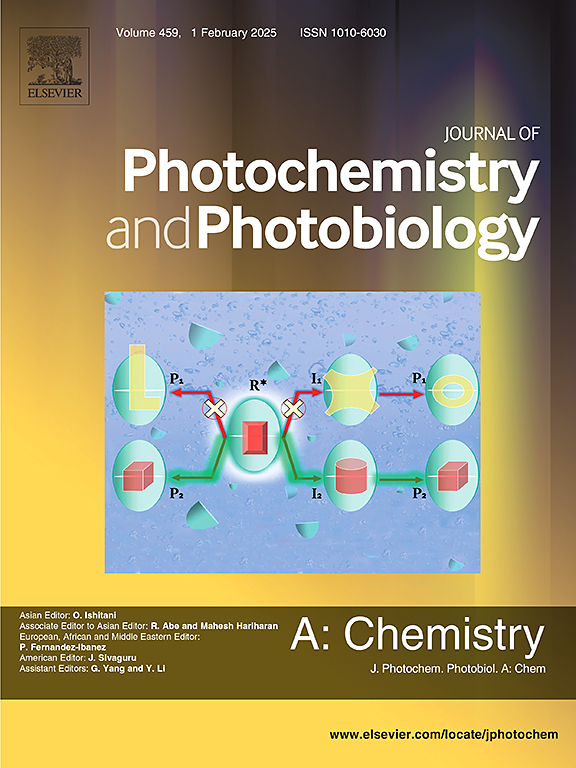不同反阴离子吡啶基荧光化合物的合成及其压致变色性能和抗菌活性
IF 4.1
3区 化学
Q2 CHEMISTRY, PHYSICAL
Journal of Photochemistry and Photobiology A-chemistry
Pub Date : 2025-06-26
DOI:10.1016/j.jphotochem.2025.116594
引用次数: 0
摘要
在有机化学领域,合成具有多种发射颜色的荧光化合物是一项有趣但极具挑战性的工作,通常需要几个繁琐的步骤,并且成本高,效率低,耗时长等。在这项贡献中,通过在室温下简单地取代伴随的阴离子,获得了吡啶基荧光化合物(称为TPB/阴离子衍生物)。结果表明,阴离子完全控制了TPB核心的光学性能,导致产物的发射波长在479 ~ 594nm之间。同时,由于TPB/阴离子衍生物的扭曲构象和分子内给电子(D)和接受电子(A)相互作用,这些TPB/阴离子衍生物对外力高度敏感,表现出优异的压变色性能。因此,我们相信负反离子与TPB框架之间的相互作用对多发射色和压变色性能有很大贡献。此外,三种TPB/阴离子衍生物由于其带正电荷的骨架(作为细菌膜的锚点)和优异的活性氧(ROS)生成能力,成功地用作抗菌材料,这种协同抗菌活性对未来克服耐药性非常有利。值得注意的是,所使用的TPB/阴离子衍生物对耐甲氧西林金黄色葡萄球菌而非大肠杆菌、粪肠杆菌和铜绿假单胞菌具有优异的选择性杀伤性能。初步研究结果证实,TPB衍生物与耐甲氧西林金黄色葡萄球菌具有较好的亲和力,对其有效抗菌活性起重要作用。本文章由计算机程序翻译,如有差异,请以英文原文为准。

Synthesis of pyridinium-based fluorescence compounds with different counter anions and their piezochromism property and antimicrobial activity
In the field of organic chemistry, synthesizing fluorescence compounds with multiple emission colors is an interesting but great challenging work, which usually requires several tedious steps and is also costly less effective, time-consuming et al. In this contribution, pyridinium-based fluorescence compounds (named as TPB/anion derivatives) were obtained by simply replacing the accompanied anions at room temperature. It was found that the anions totally managed the optical performance of the TPB core, leading to the products with emission wavelength located from 479 to 594 nm in their solid state. Meanwhile, due to the very twisted conformation and intramolecular electron donating (D) and accepting (A) interaction, these TPB/anion derivatives were highly sensitive to the external force, demonstrating the smart behavior of piezochromism property. Hereof, we convinced that the interactions between the negative counter-ion with TPB framework makes great contribution to the multiple emission colors and piezochromism property. Beyond that, three TPB/anion derivatives were successfully employed as antimicrobial materials due to the positively charged skeleton (used as anchor to the bacteria membrane) and excellent reactive oxygen species (ROS) generating capability, this synergetic antimicrobial activity is extremely favorable to overcome the drug resistance in the future. What should be noted that the used TPB/anion derivatives are of excellent selectivity of bacteria killing performance to Methicillin-resistant S. aureus rather than E. coli, E. faecalis and P. aeruginosa. T., the preliminary research result confirmed the better affinity between the TPB derivatives with Methicillin-resistant S. aureus played an important role for the effective antimicrobial activity.
求助全文
通过发布文献求助,成功后即可免费获取论文全文。
去求助
来源期刊
CiteScore
7.90
自引率
7.00%
发文量
580
审稿时长
48 days
期刊介绍:
JPPA publishes the results of fundamental studies on all aspects of chemical phenomena induced by interactions between light and molecules/matter of all kinds.
All systems capable of being described at the molecular or integrated multimolecular level are appropriate for the journal. This includes all molecular chemical species as well as biomolecular, supramolecular, polymer and other macromolecular systems, as well as solid state photochemistry. In addition, the journal publishes studies of semiconductor and other photoactive organic and inorganic materials, photocatalysis (organic, inorganic, supramolecular and superconductor).
The scope includes condensed and gas phase photochemistry, as well as synchrotron radiation chemistry. A broad range of processes and techniques in photochemistry are covered such as light induced energy, electron and proton transfer; nonlinear photochemical behavior; mechanistic investigation of photochemical reactions and identification of the products of photochemical reactions; quantum yield determinations and measurements of rate constants for primary and secondary photochemical processes; steady-state and time-resolved emission, ultrafast spectroscopic methods, single molecule spectroscopy, time resolved X-ray diffraction, luminescence microscopy, and scattering spectroscopy applied to photochemistry. Papers in emerging and applied areas such as luminescent sensors, electroluminescence, solar energy conversion, atmospheric photochemistry, environmental remediation, and related photocatalytic chemistry are also welcome.

 求助内容:
求助内容: 应助结果提醒方式:
应助结果提醒方式:


